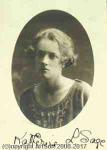Kay Sage
Kay Sage
- umelec
- Všetky umelecké diela v chronologickom poradí
- Všetky artworks podľa abecedy
- Odporúčané umelecké diela
miesto: Albany
narodený: 1898
smrť: 1963
životopis:
Katherine Linn Sage Sage. Sage had an elder sister, Anne Erskine Sage.
Anne Wheeler Ward Sage left her husband and older daughter soon after Kay's birth to live and travel in Europe with Kay as her companion. She and Henry Sage divorced in 1908, but Henry Sage continued to support his ex-wife and younger daughter, and Katherine visited him and his new wife in Albany from time to time and wrote him frequent letters.
Katherine and her mother established a home in Rapallo, Italy, but visited many other places as well, including Paris. Katherine became fluent in French and Italian, speaking colloquial versions of these languages that she learned from the servants who helped to raise her. She attended a number of schools, including the Foxcroft School in Virginia, where she became a lifelong friend of the heiress Flora Payne Whitney.
Young Katherine both drew and wrote as hobbies, but her first formal training in painting was at the Corcoran Art School in Washington, D.C., in 1919–1920. After she and her mother went back to Italy in 1920, she studied art in Rome for several years, learning conventional techniques and styles. She particularly enjoyed painting outdoors in the Roman Campagna with teacher Oronato Carlandi and fellow students. Much later, Sage stated that "these were the happiest days of my life", and she told friend and gallery owner Julien Levy in 1961 that her campagna experience shaped her "perspective idea of distance and going away." Nonetheless, in later years Sage usually claimed that she was self-taught, perhaps because, as one of her biographers, Judith Suther, states, most of what she had learned in Rome bore so little relationship to the kind of painting she eventually did that "she felt as if she had studied with no one."
Sage met a young Italian nobleman, Prince Ranieri di San Faustino, in Rome around 1923 and fell in love with him, believing at first, as she wrote to a friend in 1924, that he was "me in another form." They married on March 30, 1925. For ten years the couple lived the idle life of upper-class Italians, which Sage later described as "a stagnant swamp." She looked back on that time as years that she simply "threw away to the crows. No reason, no purpose, nothing." Her husband was content with their lifestyle, but Sage was not: as she wrote in her autobiography, China Eggs, "Some sort of inner sense in me was reserving my potentialities for something better and more constructive."
Perhaps spurred by the deaths of her father in 1933 and her sister, from tuberculosis, in 1934 (Anne had joined Katherine and her mother in Italy in the 1920s, and the sisters became quite close during Anne's final illness), Sage left her husband in 1935 with plans to build an independent life as an artist; they obtained a papal annulment of their marriage several years later. In December 1936, as she prepared to leave Italy and move to Paris, Sage had her first solo art exhibit, six oil paintings shown at the Galleria del Milione in Milan. In A House of Her Own, her 1997 biography of Sage, Judith Suther describes these works as "experimental abstract compositions."
Sage moved to Paris in March 1937 and rented a luxurious apartment there. In early 1938 she saw the International Surrealist Exhibit at Galerie Beaux-Arts, 299 pieces by 60 artists from 14 countries. She was especially struck by the paintings of Italian artist Giorgio de Chirico, which featured what Magdalena Holzhey, in a book devoted to de Chirico, calls "empty squares and receding depths, shadowy arcades and soaring towers." Sage bought one of de Chirico's paintings, La Surprise, and kept it all her life.
This exposure to Surrealism inspired Sage to begin painting in earnest. She exhibited six of her new oils in the Salon des Surindépendants show at the Porte de Versailles in the fall of 1938. These semiabstract paintings, including Afterwards and The World Is Blue, borrowed motifs and styles from de Chirico and the Surrealists but showed hints of Sage's own future work as well. Art historian Whitney Chadwick states that Sage's paintings were "imbued with an aura of purified form and a sense of motionlessness and impending doom found nowhere else in Surrealism." Around this time the artist began signing her works "Kay Sage."
Several stories are told about Sage's meeting with her future husband, Surrealist artist Yves Tanguy. One came from Greek poet Nicolas Calas, who recalled that he and Tanguy accompanied Surrealist leader André Breton to the Surindépendants exhibit and were impressed enough by Sage's paintings to seek her out. Calas claimed that Breton was sure that the paintings must have been made by a man.
More...
Wikipedia link: Click Here



